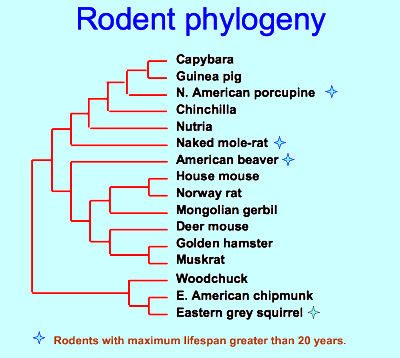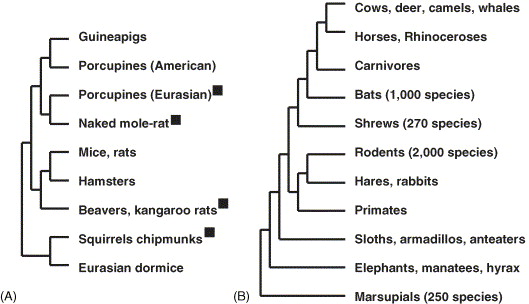Classification
The naked mole rat, also known as the Heterocephalus glaber to many biologists, is a unique animal in the order Rodentia, along with eastern grey squirrels, thirteen lined ground squirrels, and the common house mouse.
Naked mole rats belong to the domain Eukarya because they have membrane bound organelles within a cell that also has a membrane bound nucleus. They belong to the kingdom Animalia for many reasons. These include being multicellular, lacking a cell wall, and being heterotrophic. The phylum Chordata contains animals that posses a notochord at some point in their lives. The naked mole rat possesses this notochord, which then gets replaced by their spinal column during development. Being a member of the class Mammalia signifies displaying a number of characteristics which include the presence of glands (sweat and mammary), having a hair-covered body, and giving birth to live young. Since the naked mole rat displays all of these features, it makes sense that they would be classified in this class. The next level in the classification hierarchy is order. I briefly mentioned earlier that naked mole rats belong to the order Rodentia, which contains animals that have a specific set of teeth. Animals in the order Rodentia possess one set up upper incisors and one pair of lower incisors. The unique aspect of these teeth is that they continuously grow throughout the organism's life. The family Bathyergidae is made up of animals that dig. Considering naked mole rats live their entire lives underground in burrows that they form, they are most definitely considered diggers. The genus name Heterocephalus translates from Latin to mean sand rats. This description can be derived from where the naked mole rat lives, which is in the dirt. Finally, the species name for this incredible creature is Heterocephalus glaber. This can be translated to mean "hairless sand rats". This name is very fitting for naked mole rats since they only have hair on very specific and strategic parts of their body.
Domain: Eukarya
Kingdom: Animalia
Phylum: Chordata
Class: Mammalia
Order: Rodentia
Family: Bathyergidae
Genus: Heterocephalus
Species: Heterocephalus glaber
The phylogenetic tree below shows the
relationship between the different organisms that
are grouped into the
 order
Rodentia. In this tree, the rodent shown to be most
closely related to the naked mole rat is an organism
known as a
Nutria, which is a semi-aquatic rodent that is
indigenous to South America. The star that is placed
next to the naked mole rat's name indicates that it
is a rodent with a maximum life span of over 20
years, as the key at the bottom shows. As you can
see from the relatively small number of stars, it is
a rare occurrence to have a rodent with a life span
greater than 20 years.
order
Rodentia. In this tree, the rodent shown to be most
closely related to the naked mole rat is an organism
known as a
Nutria, which is a semi-aquatic rodent that is
indigenous to South America. The star that is placed
next to the naked mole rat's name indicates that it
is a rodent with a maximum life span of over 20
years, as the key at the bottom shows. As you can
see from the relatively small number of stars, it is
a rare occurrence to have a rodent with a life span
greater than 20 years.
This set of phylogenetic trees shows two different groupings at different hierarchal levels. The tree on the left is a more specific tree and shows the relationships between different organisms in the order Rodentia. This tree shows many of the same animals as the tree above, yet many are different as well. This tree helps you to see how the naked mole rat is related to many different organisms on a specific level. For example, the tree above does not show that the naked mole rat is more closely related to the Eurasian porcupine than the American porcupine. Also, the tree below shows that the naked mole rat is distantly related to the beaver, which the figure above did not depict. The tree on the right is broader, and shows how the order Rodentia is related to the other orders in the class Mammalia. Organisms that are contained in these orders range from a moose, to a snowshoe hare, to a blue whale. Knowing how the rodents fit into this phylogeny can help us better understand where the naked mole rat fits in the grand scheme of things in this world.
